|
Stay a decade or two in a city like Paris and you will sooner or later cross paths with remarkable men or, in this case, women.
I had “exiled” myself from Germany in my early twenties, done ballet and experimental theater, and was just turning the page to becoming a cultural journalist and writer when I met Meret Oppenheim. She was not the first or only remarkable woman I met. There were writers Simone de Beauvoir, Nathalie Sarraute, Monique Wittig, Christiane Rochefort; theater director Ariane Mnouchkine, actress Delphine Seyrig, dance theater revolutionary Pina Bausch, to name a few. Some of them appear in my recent memoir Kiss Me Again, Paris as mentors, guides and challengers. They were accomplished, successful, powerful women.
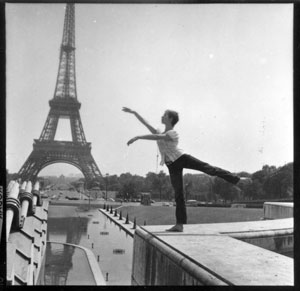
R.S. with Eiffel Tower
The writer Christiane Rochefort (whose books were turned into famous movies: Le mépris with Brigitte Bardot, for example) plays a role in my memoir as an intellectual mentor who taught me how to think creatively about myself, and critically about my sexual obsessions. The lesbian poet and theorist Monique Wittig, the erotic “prince” of the women’s movement, appears as a nemesis and potential rival in my love affairs. Pina Bausch makes an impact even before I met her: I used a ticket to her explosive dance theater piece Café Müller in an attempt to seduce an elusive lover.
Meret Oppenheim
But Meret Oppenheim (who died in 1986), has a particular place in my memories because she was such an irresistible challenge for me, both in her work and in her person—as attractive, beautiful, and mysterious in her sixties as she had been in her early twenties. In my memoir, I start out disagreeing with my lover Claude about an urban legend that has spun itself around Meret’s bohemian nights in Paris, in the 1930s.
* * *
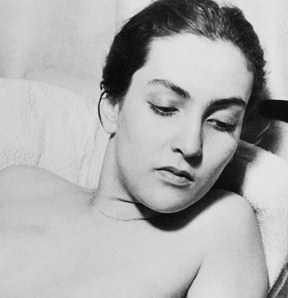
“The last time I partied at La Coupole, I was with Claude. Claude, an actress on the rise, who captivated everyone with her smoldering promise of sex. I remembered our talk that night, how we disagreed in the way we typically disagreed about anything unimportant because of the deeper sexual tension between us, the always unsettled tug of seduction and surrender, top and bottom, boy and girl. We had argued over the heydays of bohemian life before the war, when Kiki de Montparnasse reigned over the quartier. Was it a myth that the café night life was wilder in the Roaring Twenties and Thirties than today? Was it true that a notorious young surrealist woman artist had peed one night into a gentleman’s top hat here, at La Coupole? It was a story that had gone around forever; I’d heard it from my journalist colleague Ruth Henry who knew the artist, who didn’t
elaborate. Claude claimed to know it was true. It was nothing compared to what she’d seen with her own eyes just yesterday. She was adamant about it. The way she provocatively cocked her head on her stubborn neck told me she would insist on being right no matter what I said. She dared me to contradict her and I obliged. I couldn’t resist. I loved to watch her more dangerous moods, the glint of anger and pleasure in her almond eyes. I never knew to what extent she was doing this stuff herself. I sensed the innuendo in the positions she took, but she kept her secrets, and so did I.“
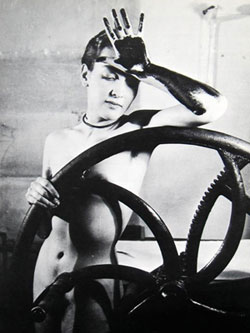 |
So, was it true? Whenever I asked Meret about the gentleman’s top hat, she would give me the half-mocking, half-pleased smile of a sphinx. One had to draw one’s own conclusions, considering her unconventional art work, her many lovers (Max Ernst, Giacometti, et al), the ease with which she had stripped for a spectacular series of nudes for Man Ray’s camera; the fact that in her late sixties, she still had lovers (men and women) and loved to party at La Coupole and other night cafés.
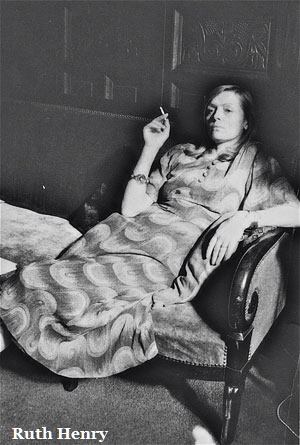 |
I had met MO (as she signed her paintings and objects) in my theater days. I had got a meaty role in the world première of Louis Ferdinand Céline’s early play L’Eglise, a role that could be described as “Broadway dancer turned into Angel of Death.” The German journalist Ruth Henry brought Meret to see me in the play, and next, I got invited to one of Ruth’s afternoon salons—gatherings at her Art Nouveau apartment on Blvd Edgar Quinet, a small “art museum,” stuffed with books and photographs, paintings and collages. Meret was just then returning to fame after the decades-long depression and silence she had fallen into after her early Paris glory. I didn’t know much about her, not much more than having seen Man Ray’s spectacular photographs. I instantly fell in love with her as she
had the same androgynous beauty as she did back in her youth , when everyone fell in love with her.
R.S. in L'Eglise
Of course, Picasso had been among her admirers, and one day in the early 1930s, at a café, he had noticed the fur-lined bracelet Meret had made for herself. It was a cheap little metal bracelet that she had bought at a Prix Uni and decorated with a glued-on strip of fur. Picasso’s appreciation led Meret to comment that anything, in fact, could be covered by fur…
Soon thereafter, her “Fur-lined Teacup” created a sensation among Paris artists and surrealists. It was snatched up in 1936 by the New York Museum of Modern Art and made the young German-Jewish artist famous over night.
So what happened to her fame? I wanted to know, sitting across from her at Ruth’s salon. Here is how I remembered the moment:
“Too much too soon,” she explained, sitting across from me on Ruth’s bulky sofa. How could she tell, back then, if she really was an artist? Was it talent or just looks? Artist-subject or beautiful object of desire for men (and certain women)? Not knowing the answer, she said, was her undoing. Ruth pulled out some art book from her vast collection and showed me pictures of the furry cup, saucer and spoon, an object considered the surrealist objet par excellence. I grasped its absurdity, its feline elegance and sexual aura, and I got the joke of Meret’s calling it “Le déjeuner en fourrure” (Luncheon in Fur) as an allusion to Manet’s provocative painting “Le déjeuner sur l’herbe” (Luncheon on the Grass).
That afternoon, Ruth, in her role as salonnière, hostess and caretaker, pressed upon Meret that she would need an assistant now that she was getting famous again and the Paris gallerists wanted her work and all the art magazines and the American feminists wanted to interview her.
“My German protégée here needs a job,” Ruth said. “Renate will help you write your checks and all that.”
Meret looked me over with a self-mocking smile and anxious eyes. “But what are we going to do with you?” I imagined she wasn’t sure how to share her studio space with another person. I wasn’t sure how to handle her beauty and artistic power.
“We could of course dress you up as a Moor-boy,” she said, peering at me like an apprehensive, but curious bird, “and send you to the door with a silver tray to receive the cartes de visite…”
Another surreal idea, given the primitive, monkish atelier she occupied in a dilapidated back alley on Avenue Jean Moulin. The idea pleased everyone, and we started working together every morning for a number of years. “
In my years of working for MO, I was often baffled by her sense of humor. I was a young romantic, and a sense of humor, self-humor only came to me later in life. But I understood the tea cup and saw it as a three-dimensional parallel to Gertrude Stein’s line, “A rose is a rose is a rose is a rose” – a puzzle you will never entirely solve. I loved the playfulness and absurd irony in much of her work, for example the two white ladies pumps, tied up and served on a platter like a chicken, called “My Nurse, Ma Gouvernante, Mein Kindermädchen,” or the pair of laced-up boots, standing face to face, glued together by their tip, entitled “The Couple.”
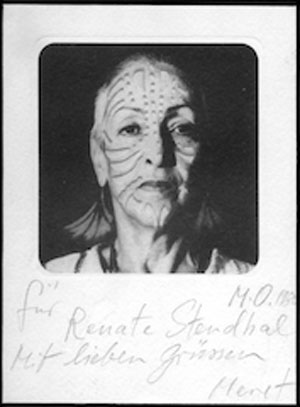 |
I was touched by the failed attempts of young Meret Oppenheim to survive in Paris in the 30s by creating fashion designs. Her designs didn’t sell; they proved too surreal, bizarre and macabre: a necklace made of little bones, an evening gown with straps that clip to the woman’s nipples, or gloves decorated with marked veins of a hand. But today these designs are being picked up and realized by artisans. With our post-modern understanding, Oppenheim’s fame keeps growing, and the paradoxical humor of her fashion designs is now considered the ultimate cool. You can actually buy some of them and wear them. How about MO’s Sugar Ring: a classic gold band with a clipped-in sugar cube? You can be chic and lick away for roughly $2, 000.
Renate Stendhal’s memoir Kiss Me Again, Paris, was excerpted in Scene4 and the Chicago Literary Quarterly. It won a pre-publication award from the Women’s National Book Association, and is available at Amazon.
|